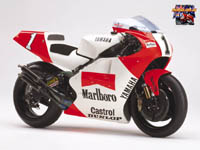 The Deltabox frame would continue to be a leader on the GP scene while undergoing a number of changes like the structure of the main tube (reinforcing studs added inside the squared cross-section tube), optimizing of alloy types and rigidity balance, etc. The next big turning point in this frame’s design would come in 1993 model YZR500, called the OWF2.
The Deltabox frame would continue to be a leader on the GP scene while undergoing a number of changes like the structure of the main tube (reinforcing studs added inside the squared cross-section tube), optimizing of alloy types and rigidity balance, etc. The next big turning point in this frame’s design would come in 1993 model YZR500, called the OWF2.
“In an effort to achieve a dramatic improvement in the rigidity of the frame for the OWF2 of ’93, we switched to extruded aluminium parts. Extruded aluminium is made by a process of heating up the aluminium stock to an appropriate temperature and then forcing it through a die to produce tube stock of the desired shape. Because the extrusion process enables more complex shapes than the type of panel stock we had been using and also a higher degree of precision in shape and dimensions, we believed it would be advantageous for improving rigidity.
“When we saw the test results, it in fact gave us much higher rigidity figures than we had ever hoped for. It was a machine with this new frame that Wayne Rainey rode to three consecutive 500cc titles. Studying the motion of the machine in actual racing, however, we observed that there was not a good harmony between the torsion characteristics of the frame itself and the functioning range of the suspension. And, we were not getting good feedback about the handling character at super-high speeds. This was part of the reason the Rainey used an ROC Yamaha frame from the eighth round of that year’s series,” says Mr. Masahiko Nakajima, who was an engineer of OWF2.
Having learned these lessons, the next spec, the OWF9, once again returned to the previous panel-stock frame. This was a period when the focus of Yamaha’s frame design turned to the problem of how to best use the torsion characteristics of an aluminium frame to contribute to handling performance.
The aluminium Deltabox frame technology was eventually fed back to Yamaha’s production supersport models and as is well known today, it went on to have a decisive influence on the world standard for production supersport bikes by all the makers.
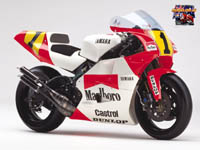 In 1990, Wayne Rainey and John Kocinski brought Yamaha double championship title in the 500 and 250 classes. In ’91 Kocinski also moved up to the 500cc class and the YZR500 and this was also the year that the OWD3 spec YZR500 adopted a full-fledged computerised electronic suspension (CES) for the first time. The machine mounting the CES suspension jointly developed with Ohlins would be the one Rainey rode to his second consecutive title in ’91.
In 1990, Wayne Rainey and John Kocinski brought Yamaha double championship title in the 500 and 250 classes. In ’91 Kocinski also moved up to the 500cc class and the YZR500 and this was also the year that the OWD3 spec YZR500 adopted a full-fledged computerised electronic suspension (CES) for the first time. The machine mounting the CES suspension jointly developed with Ohlins would be the one Rainey rode to his second consecutive title in ’91.
The system consisted of (1) a stroke sensor, (2) a control unit and (3) the shock absorber. The stroke sensor was positioned on a parallel axis with the shock absorber to measure the volume and speed of its stroke. In the system, the stroke volume and speed data is sent to the control unit where it is filtered through a pre-programmed map to render an electronic current that is then sent to the shock absorber to drive a solenoid valve that precisely regulates the flow of hydraulic fluid to provide exactly the right amount of cushioning force on both the compression and rebound strokes. The advantage of this system was that it enabled precise setting of the desired damping force in the stroke in accordance with course conditions and/or rider preference simply by rewriting the memory in the control unit’s microcomputer from an external terminal.
“We had begun doing tests with a CES rear suspension from 1989, but ’91 was the first year we used it for the whole GP season. What you could call the “active” suspensions on automobiles were not advantageous for motorcycles because of the complicated parts like the hydraulic fluid pump, the system weight and the space it requires. So, we developed a system that built the damping force control function into the shock absorber itself. By then connecting this to an electronic control unit, the CES system we developed became in effect a passive system that achieved the same effect as an active system. We also provided a fingertip switch that enable the rider to switch between three or so different control maps,” explains Mr. Nakajima.
Although the system was not mounted on later YZR500s, the know-how gained from the development of the CES system would contribute to the later versions of Yamaha’s suspensions. The Monocross suspension that began with considerations about interference with the intake system and chassis material balances would evolve to concerns for rising-rate effect, maturation of the bottom-link format and finally electronic control.
With Wayne Rainey’s successive titles in 1990 and ’91, Yamaha won both the GP500 manufacturer and rider titles two consecutive years. At the same time, however, the number of machines competing in 500cc Grands Prix was decreasing steadily, and some were even beginning to worry about whether or not the championships would survive.
In answer to this need to stimulate the GP race scene, Yamaha announced in September of ’91 that it would provide its YZR500 engine to any of the prominent constructors in Europe at the time that wished to use it. Actual sales began in ’92 was a part of Yamaha’s efforts to promote the sport of motorcycle racing. In fact, Europe had a long tradition of GP teams that used engines by the makers mounted on frames built by the constructors to produce competition machines. It was Yamaha’s belief that the racing scene would be stimulated by the presence of new teams using machines constructed in Europe according to this tradition.
 The release of technology in the form of these engine sales brought a big change to GP racing. A full two-thirds of the machines on the starting grid for the 500cc class on March 29 in the ’92 GP series’ opening round at Suzuka were powered by the Yamaha YZR500 engine and the number of machines was larger. Riding the ’92 spec OWEO (YZR500) were Rainey, John Kocinski, Juan Garriga, Miguel Duhamel, Niall Mackenzie, Kevin Magee and Norihiko Fujiwara, while Randy Mamola and Eddie Laycock competed on 1990 model OWC1s fitted with ’92-spec motors. In addition, 14 other riders competed on Harris Yamaha and ROC Yamaha machines.
The release of technology in the form of these engine sales brought a big change to GP racing. A full two-thirds of the machines on the starting grid for the 500cc class on March 29 in the ’92 GP series’ opening round at Suzuka were powered by the Yamaha YZR500 engine and the number of machines was larger. Riding the ’92 spec OWEO (YZR500) were Rainey, John Kocinski, Juan Garriga, Miguel Duhamel, Niall Mackenzie, Kevin Magee and Norihiko Fujiwara, while Randy Mamola and Eddie Laycock competed on 1990 model OWC1s fitted with ’92-spec motors. In addition, 14 other riders competed on Harris Yamaha and ROC Yamaha machines.
“We considered working to stimulate the 500cc class to a mission just as important to us as winning the title. The European constructor machines from Harris and ROC mounting Yamaha engines gave many more riders a chance to compete in the GP and made the races more exciting and competitive,” says Mr. Shyuji Sakurada who was a chief of this project. Along with the challenge of winning the GP, Yamaha was equally eager to promote the sport itself.
During this period, Yamaha released vital machine technologies to ROC and Harris. Perhaps never before in the history of the GP had a factory provided constructors with design blueprints and full instructions on the full details of maintenance and setting methods like this. And, the base machine to which this information applied was the OWC1 that Rainey had won the title with in 1990.
Using made-in-Europe aluminium stock, the constructors built their own brand bikes with chassis equivalent to the YZR500 (OWC1) to enter in the GP. Between 1992 and ’94 ROC Yamaha and Harris Yamaha placed fifth and sixth in the constructors championship ranking. It was not only due to the competitiveness of their Yamaha engines but also a measure of the all-round qualities of the machines, ranging from set-up to serviceability. The fact that such competitive machines could be built without special aluminium alloys but just commercially available aluminium stock was also a statement about the basic soundness of the Yamaha chassis designs. Beyond the successive championship titles won by Yamaha in these years (1990 to 1992 by Rainey), we also see an important aspect of the Yamaha corporate philosophy in its willingness to release technical information for the sake of the sport.
Chronology
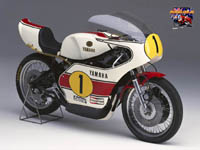 OW20 (1973-74) – Yamaha’s first 500cc factory machine
OW20 (1973-74) – Yamaha’s first 500cc factory machine
The OW20 was Yamaha’s first factory machine built to compete in the GP 500cc class. This machine mounted a liquid-cooled two-stroke parallel-four piston reed valve engine on a chromium molybdenum steel frame with disc brakes front and rear. It debuted at the opening round of the 1973 series in April, the French GP and Jarno Saarinen piloted it to a debut win.
The following year, 1974, it became even more competitive with the adoption of the Monocross suspension. Giacomo Agostini signed with Yamaha for the first time and competed with teammate Tevo Lansivuori. Agostini won rounds three and six and Lansivuori won round eight of the series. This, combined with the points earned by other Yamaha riders gave Yamaha its first manufacturers title in the 500cc class.
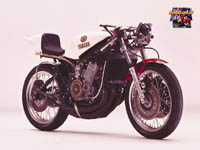 OW23 (1974-75)- Developed specifically for Grands Prix
OW23 (1974-75)- Developed specifically for Grands Prix
Debuting at the Belgian GP of 1974, this was Yamaha’s first machine developed specifically for the 500cc class. It is the machine that Giacomo Agostini would ride to win the GP500 title in ’75, giving Yamaha its first individual championship in its third year of GP500 competition. Compared to the OW20 which had been developed jointly with the 700cc machine for Daytona competition with cylinder bored down to 500cc, the OW23 was considerably lighter and more compact in both engine and chassis and had a shorter wheelbase as well.
As a feature to reduce setup time, it also adopted a cassette type transmission. It was the same type as the on the MZ and MV Agusta, with the main shaft, drive shaft and shifter assembly as one unit that that was extractable on the opposite side from the sprocket, but it also featured detail maturation and improved reliability. This cassette transmission would become the base unit for those used eventually on the TZ250 production racer and the production TZR250SPR. Also the new muffler shape that would be called a stepped taper type featured a gentle trumpet shape in the defuser portion and a bowl shape at the rear portion of the expansion chamber that served to improve max. power output and torque in post-peak range. The square-type rear arm was another defining feature. The following year, 1976, Yamaha did not compete with a factory team in the GP, but Johnny Cecotto rode the OW23 to a second-place finish in the series opener.
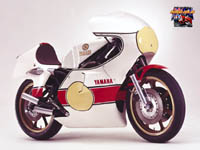 OW35 (1977)- New engine with revised bore and stroke
OW35 (1977)- New engine with revised bore and stroke
The 1977 model YZR500 (OW35) was the factory machine Yamaha returned to 500cc competition with after a one-year hiatus. The piston reed valve intake that had been used on the OW20 and OW23 was replaced by a piston valve system. Also, the cylinder pitch, which had been kept as small as possible on the OW23 for the sake of compactness, was increased (92 to 115) in order to allow more design freedom for the scavenging port. With this, the bore x stroke changed from the former 54 x 54 to a high-revving type 56 x 50.6 and a power jet type carburettor was adopted. Revisions were also made to the chassis to optimize aerodynamics with the rider’s form figured into the equation. Riding this machine, Steve Baker mounted the podium six times to finish the ’77 season ranked in second place.
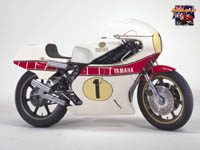 OW35K: Roberts’ title winner
OW35K: Roberts’ title winner
OW35K (1977-78) – Roberts rides the YPVS model to his first title
Taking the 1977 GP model OW35 as its base, the OW35K adopted Yamaha’s new YPVS (Yamaha Power Valve System) technology for the first time. By making possible variable exhaust timing, this revolutionary device helped remove torque valleys from the engine’s power development characteristics and thus led to dramatic shortening of lap times. This YPVS had first been used in GP competition secretly from the Finnish GP in ’77. Johnny Cecotto rode this machine to wins at the Finnish GP and the Czechoslovakia GP to finish the season fourth, while Kenny Roberts won four of the series’ 11 rounds to win his first of what would be three consecutive 500cc titles.
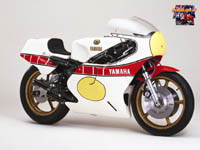 OW45 (1979) – The representative piston valve parallel four
OW45 (1979) – The representative piston valve parallel four
As the second generation YPVS-equipped model, the OW45 employed a processing technique called honing relief to shave the area around the exhaust port to micron accuracy in order to further increase reliability of the YPVS function. The VM carburettor adopted on this model that eliminated the air side cut-away also contributed to outstanding acceleration performance. In the ’79 series this machine was ridden by Roberts, Cecotto and Christian Sarron. After missing the series opener due to injuries, Roberts returned to win round two at Salzburgring, then place second at round two in West Germany, win round four at Imola and round five in Spain. This put him on top in the ranking and on his way to his second consecutive season title with five season wins.
This OW45 would be representative of six generations of YZR500 machines powered by a liquid-cooled, parallel-four, piston-valve engines that continued from the OW35 and OW35K through the OW45, OW48, OW48R and OW53. It also served as the base model for the TZ500 production road racer released in 1980.
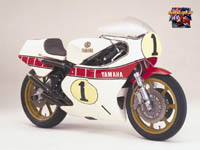 OW48 (1980) – The first aluminium frame model
OW48 (1980) – The first aluminium frame model
The OW48 spec was the first YZR500 to adopt an aluminium frame. This frame, using squared aluminium stock, greatly reduced the weight of the chassis. Weight reducing technologies were also employed in other parts of the machine as well. Improvements to the YPVS system boosted power across the full rpm range, and improvements to the cooling system ensured greater reliability. Compact designs for many of the machine components further reduced overall size. The front and rear suspensions were also re-designed, and the front brake was given an aluminium caliper. Roberts started the ’80 GP500 season with three consecutive wins at the opener at Misano, round two at Jarama and round three at Paul Ricard. Roberts won his third consecutive championship title this year running five of the eight rounds on this OW48 and the remaining three on the OW48R spec which featured rear exhaust on the two outer cylinders.
OW48R (1980) – Parallel four for Roberts’ third title
The OW48R spec introduced at the Dutch GP, round four of the ’80 series, was not based on the OW48 with its aluminium frame. It adopted a steel frame of the type used on the previous year’s OW45 spec and mounted an engine with rear-directional (reverse) exhaust for increased power output. Introducing rear exhaust on the first and fourth cylinders, in other words the two outer cylinders, increased power by 7PS. The R in this spec’s name stood for reverse.
Roberts began the ’80 GP500 season with three consecutive wins on the OW48 and then rode the OW48R in round four, the Dutch GP. In this race he was forced to retire due to an air leak in one of his tires, but he rode this spec again at round five, the Belgian GP, and finished third. For rounds six and seven he returned to the OW48 and mounted the podium with two second-place finishes. For the final round he rode a OW48R with aluminium frame (prototype for the next year’s OW53) and finished fourth. While changing machines three times in the course of the season Roberts won his third consecutive title.
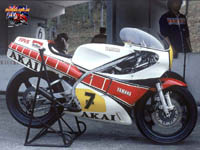 OW53 (1981) – The last parallel four model
OW53 (1981) – The last parallel four model
The OW53 spec that appeared in 1981 was the successor to the OW48R with its rear-directional exhaust configuration for the two outer cylinders. It would also become the last YZR500 to mount a parallel-four engine. The frame was a further maturation of the squared cross-section aluminium frame first introduced on the OW48 and mounted on it was the same type of rear exhaust engine as the OW48R. The basic dimensions were kept the same as the OW48. This year, 1981 would see the debut of the first square-four engine YZR500 (OW54), ridden by Roberts. Meanwhile, this OW53 would be ridden by Barry Sheene is the first three rounds of the ’81 series, where he finished fourth at Salzburgring, sixth at Hockenheim and third at Monza.
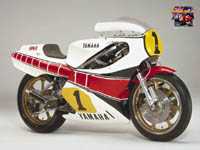 OW54 (1981)- Square-four with rotary disc valve
OW54 (1981)- Square-four with rotary disc valve
The 1981 model YZR500 (OW54) was the first Yamaha racer to mount a square-four format engine on an aluminium frame. For the intake system the conventional piston valve was replaced by a rotary disc valve with its outstanding power development characteristics in the high-speed range. On this machine Roberts won the first two rounds of the ’81 season, the West German GP and Monza GP. With brake trouble and other unlucky incidents in later rounds, Roberts eventually finished the season ranked third. From the fourth round at Paul Ricard, Barry Sheene also rode the OW54 won the final round at Anderstorp.
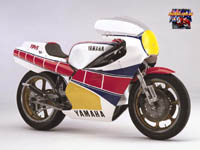 OW60 (1982)- The second-generation square-four
OW60 (1982)- The second-generation square-four
The OW60 spec debuted at the first round of the ’82 season and was the second-generation YZR500 to mount the Yamaha square-four engine. It was six kg lighter then the OW54, which has suffered from its weight disadvantage. It was also a model that saw a new suspension challenge with the introduction of a bell crank to move the rear shock absorber. On this model, Roberts and Sheene finished one-two at the season opener, the Argentina GP. But this would be the only GP win for the OW60, as Roberts switched to a new machine (the V4 engine OW61) from the second round of the series. It was Graeme Crosby who would ride the OW60 throughout the season, and although he never won a round, he continued to finish high in the points and ended the season ranked second, the highest of any Yamaha rider. This machine also mounted an adjustable steering pipe as a test feature.
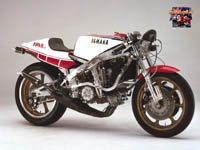 OW61 (1982) – First V4 engine on a 500cc GP machine
OW61 (1982) – First V4 engine on a 500cc GP machine
The OW61 was not only the first YZR500 to mount a V4 engine, it was also the first ever by any manufacturer for a two-stroke GP500 machine. The other definitive features of this model were its innovative lateral rear suspension with the shock positioned at a 90-degree angle to the direction of forward motion and a unique frame that eliminated the under-loop, which would become the forerunner of Yamaha’s famous Deltabox frame. This was the model that pioneered the two-stroke V4 engine that would eventually become the standard in GP500 racing. After winning the season opener of the ’82 GP on the square-four OW60, Roberts switched to a new V4 engine OW61 for round two at Salzburgring. In this, the OW61’s debut race, Roberts finished third. Riding the OW61 at round four in Jarama, Roberts beat his personal best lap time by a full second on his way to the win.
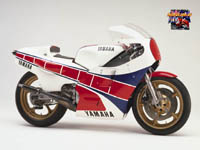 OW70 (1983)- Arrival of the Deltabox frame
OW70 (1983)- Arrival of the Deltabox frame
The 1983 model YZR500 (OW70) was the second-generation V4 powered machine and the first to adopt Yamaha’s new aluminium Deltabox frame and 17-inch front wheel. Further maturation of the previous year’s OW61 and an increase in inertial mass for the flywheel helped handling stability, while overall competitiveness was also improved with the adoption of a new rear suspension (mid-season change from bell crank type to bottom-link type) and revision of frame rigidity. This year Kenny Roberts on the OW70 and Freddie Spencer on the three-cylinder Honda NS500 staged a head-to-head battle that continued to the final round, were Spencer won the title by a hair’s breadth. It had been one of the greatest showdowns in GP history with each rider winning six rounds and three second places and each winning six pole positions. Roberts finished this ’83 season a close second while Eddie Lawson also riding the OW70, finished fourth.
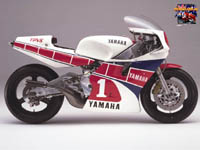 OW76 of 1984
OW76 of 1984
OW76 (1984) – Lawson’s first title
The OW76 spec that appeared in 1984 was characterized by the change from the rotary disc valve intake system used up until the OW70 to a crankcase reed valve system. By making effective use of the crankcase reed valve intake that was coming into use at the time with a plastic resin reed, this model achieved smoother power development and better starting character. The system adopted a structure in which the rotary disc valve drive axis positioned on the upper portion of the crankcase was replaced by a reed chamber. At the time, Yamaha was already using a crankcase reed valve system on its Mate utility motorcycle series, but its adoption on the YZR500 brought a whole new image to this technology. In his second year of GP competition, Eddie Lawson had become Yamaha’s ace rider, winning the season opener, the South Africa GP, and going on to claim his first title with four wins during this year’s series.
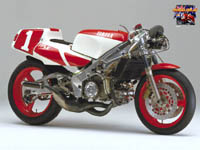 OW81 (1985-86) – Opposed revolution twin cranks
OW81 (1985-86) – Opposed revolution twin cranks
The OW81 spec used in 1985 and ’86 adopted a V4 engine completely redesigned with the aim of making the engine a member contributing to handling stability. On the conventional V-4 engine, both crankshafts were made to revolve in the direction of forward motion. With the OW81, however, the two shafts were spun in opposite directions (rear shaft in the in the direction of forward motion and front shaft in the opposite direction) with the drive force being drawn from the rear shaft. This minimized the gyro moment effect on handling stability, thus contributing to outstanding handling stability. In ’85 Lawson rode this machine to second place in the season ranking and Christian Sarron finished third on it as well. The further evolved ’86 version featured boosted power output (140PS to 145PS) optimized dimensions and a new seat shape. On this machine Lawson won back the GP title, his second. Meanwhile, in the All Japan Championships, Tadahiko Taira won his third consecutive 500cc title on this machine, which would remain the base model as the YZR500 continued to evolve into the ’90s.
Wayne Rainey’s 1987 OW86 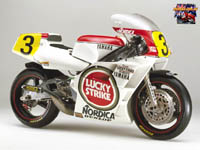
OW86 (1987)- Yamaha’s fourth manufacturers title
To accommodate the new noise regulation went into effect in the GP from the 1987 season, changes were made in the exhaust system, including a lengthening of the tail pipe to reduce the noise level from 110 to 105 decibels. At the same time, the maturation of the model continued with improvements like a revised engine position, increased radiator capacity and improved cooling performance with an expansion of the air duct. The power output was also boosted from over 145PS to over 148PS. This year (1987) the first 500cc class Japan round of the World GP at the Suzuka circuit and Randy Mamola won it in the rain on the OW86. That season Lawson won six rounds and Mamola three to give Yamaha its fourth manufacturers championship.
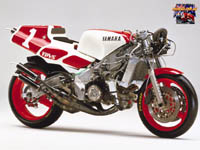 OW98 (1988)- Right-side twin mufflers
OW98 (1988)- Right-side twin mufflers
On the OW98 that made its appearance in 1988 the V bank was opened from 60 to 70 degrees. This change was made to gain more area for the reed valve itself and more space to increase intake volume than the original V4 block which had been designed for the rotary disc intake system. Also, a new exhaust layout was adopted in which the exhaust pipes from the lower (front) two cylinders were crossed once under the engine and then both brought out on the right rear side. To accommodate this, a left-right asymmetrical rear arm with a large curve on the upper right side was adopted.
This year, Lawson won seven rounds of the GP500 series to claim his third title. Kevin Magee and Wayne Rainey also won one round each on the YZR500 to give Yamaha its third consecutive and fifth overall manufacturers title. In the twelfth round of the series at Donington Park, Rainey won on a YZR500 after adopting a carbon front disc brake for the first time.
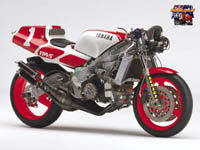
 OWA8 (1989) – Data-recording device introduced
OWA8 (1989) – Data-recording device introduced
The OWA8 that appeared in 1989 was characterized by the introduction of a full-fledged data recording function that recorded data from sensors about the running conditions of the machine throughout the duration of its run. With its ability to record data about a wide range of factors including engine rpm, bike speed, suspension stroke, steering angle during turns, combustion chamber temperature and detonation, this machine proved to be extremely helpful in providing numerical information that could be shared by the engineers, mechanics, developers and riders to help in determining directions for settings. This year Lawson scored three wins to finish the season in second place, followed by Christian Sarron in third. Meanwhile, in the All Japan Championships, Norihiko Fujiwara grabbed his third consecutive season title on this machine.
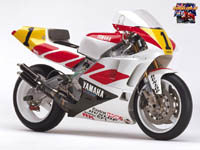 OWC1 (1990) – Rainey wins world title
OWC1 (1990) – Rainey wins world title
The OWC1 spec that Yamaha rolled out in 1990 had improved handling stability due to dimension changes including a head pipe position that was closer to the rider than the conventional machine and a lower caster angle. The power output was also increased to 155PS from 150PS for the previous year’s model. On this machine Rainey won a total of seven rounds to claim his first GP title. This contributed to Yamaha’s sixth manufactures championship. This OWC1 would also be the base machine that Yamaha would offer to European constructors in 1992 in the form of engine sales and chassis data as a move to stimulate the sport of motorcycle racing and encourage technology sharing. This would lead to Harris Yamaha and ROC Yamaha entering machines based on the OWC1.
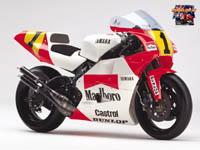 OWD3 (1991)- The machine Rainey rode to title two
OWD3 (1991)- The machine Rainey rode to title two
Due in part to the new regulation that required 500s to weigh more than 130 kg, the OWD3 spec introduced in 1991 sought to increase competitiveness with the adoption of an electronic-control suspension (CES). It also adopted a full-fledged adjustable pivot assembly designed to hold the influence of return force from the road surface on the chain tension to a minimum while also enabling setting adjustments to accommodate different course conditions. Rainey won six rounds of the ’91 series on this machine to claim his second world title. John Kocinski also won one round to help bring Yamaha its seventh manufacturers title. This OWD3 was also ridden to a series title in the All Japan Championships by Peter Goddard. This gave Yamaha the greatest number of titles of any maker in the 13-year history (1981-1993) of the All Japan 500cc class with eight.
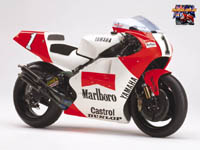 OWE0 (1992) – Rainey’s third title
OWE0 (1992) – Rainey’s third title
The OWE0 that appeared in 1992 boasted a power output of 160PS, up from 155PS the year before. Also, based on the premise that torque character is the product of a combination of combustion torque and inertial torque from the revolution of the crankshaft, a new phased simultaneous combustion interval (the diagonally opposed cylinders fired simultaneously at a 0-degree and 90-degree interval as opposed to the previous 180-degree interval) was adopted from the ninth round of this year’s series, the Hungary GP. This improved traction in the low- to mid-speed range and power coming out of the turns. On this machine Rainey won his third title in as many years. Kocinski also scored one win and finished the season in third place.
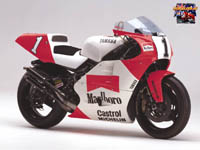 Rainey’s OWF2 of 1993
Rainey’s OWF2 of 1993
OWF2 (1993)- Adopting an extruded aluminium frame
In order to accommodate a new engine with boosted power output of 170PS (160PS for the previous year), the OWF2 that Yamaha rolled out in 1993 featured a frame designed for greater rigidity. The aluminium used in main frame was changed from three-section extruded stock that provided much greater rigidity, especially with regards to lateral torsion. Rainey rode this machine from the opening round of the ’93 series to round seven, the Dutch GP, scoring wins in the Malaysia GP and the Japan GP and contributing to Yamaha’s eighth manufacturers title. From round eight, Rainey rode a ROC Yamaha machine (with the same type of frame as the OWC1) constructed in Europe with Yamaha technological assistance.
OWF9 (1994-95) – Forced air box boosts performance
The 1994 model OWF9 was the machine that Luca Cadalora rode throughout that year’s GP series to second pla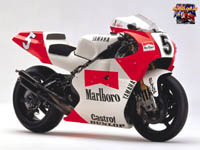 ce for the season with wins at the U.S. GP and the Barcelona GP. While the OWF2 spec of the previous year had featured an extruded aluminium frame, further pursuit of power development and rigidity balance factors led to a return to a panel stock aluminium frame with this model. Based on development efforts to improve the aerodynamic characteristics over preceding models led to a cowl design that shifted the air intake mouth toward the inside. Norick Abe became a full-time competitor on this machine starting from this year’s British GP.
ce for the season with wins at the U.S. GP and the Barcelona GP. While the OWF2 spec of the previous year had featured an extruded aluminium frame, further pursuit of power development and rigidity balance factors led to a return to a panel stock aluminium frame with this model. Based on development efforts to improve the aerodynamic characteristics over preceding models led to a cowl design that shifted the air intake mouth toward the inside. Norick Abe became a full-time competitor on this machine starting from this year’s British GP.
A further matured version of the OWF9 was also used in the ’95 season, characterized by features like a full-fledged ram-air function for the air box produced at Yamaha’s London R&D base, Activa, that increased intake performance.























